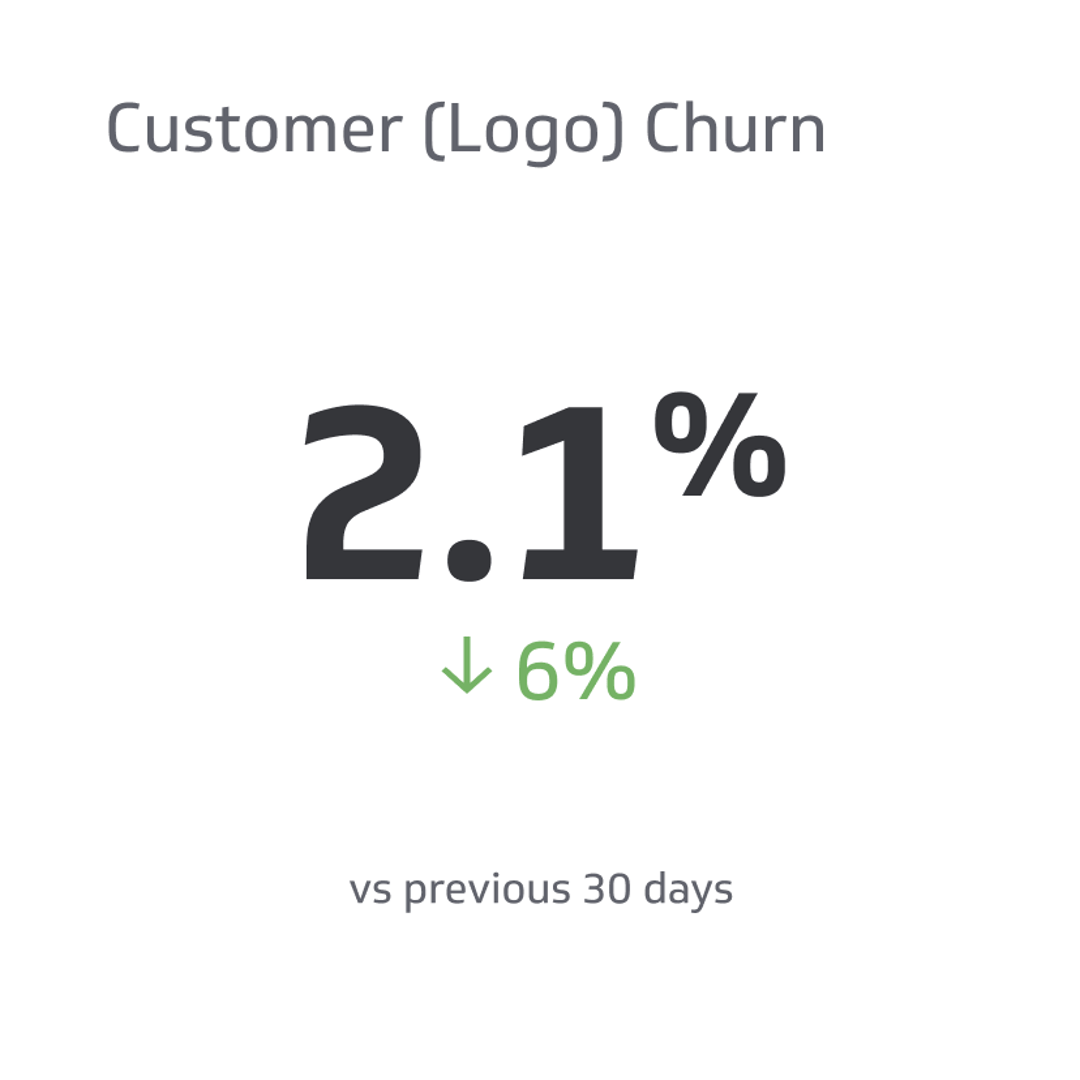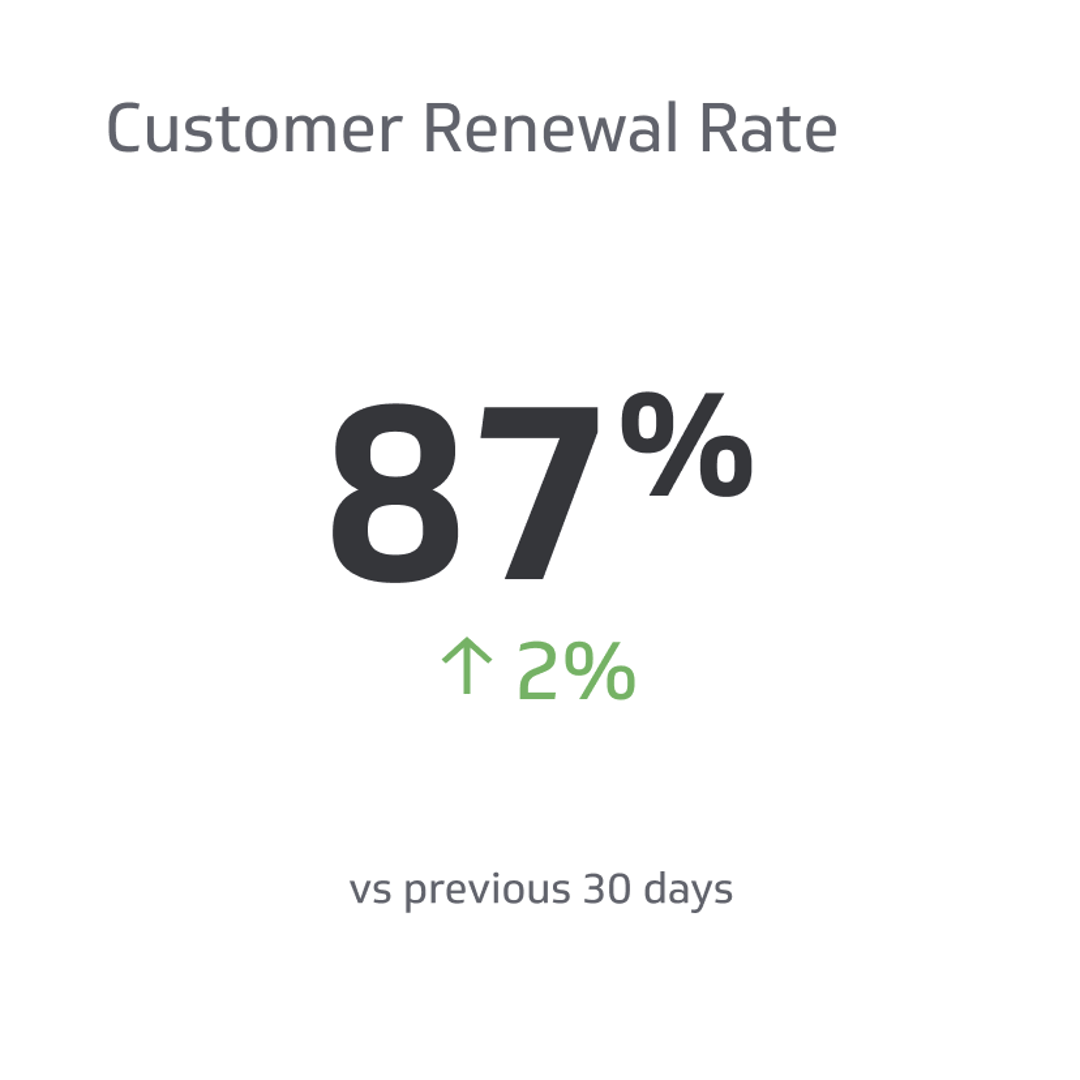Customer (Logo) Churn
This metric is vital for companies to track because it can indicate potential problems with their product, service, or customer support.
Track all your SaaS KPIs in one place
Sign up for free and start making decisions for your business with confidence.
 Churn.png)
Customer churn is a critical metric measuring the rate customers terminate their relationship with a company. When customers stop doing business with a company, it can significantly impact the company's revenue and profitability.
This SaaS metric is vital for companies to track because it can indicate potential problems with their product, service, or customer support.
In this article, we will explore what customer logo churn is, how to calculate it, and why it matters for businesses.
What Is the Purpose of Customer and Logo Churn?
Tracking customer and logo churn rates is critical for businesses to identify and address customer retention issues. By understanding why customers leave, companies can make informed decisions on improving their product or service offerings, customer service, and overall customer experience.
A high customer churn rate can be detrimental to a company's reputation, as it suggests that customers are not satisfied with the company's product or service. Losing customers can also impact a company's brand image and reputation, making it difficult to attract new consumers or maintain existing ones.
While a high logo churn can be problematic to companies, some data can come out that shows positive trends in customer satisfaction.
For instance, a low customer churn rate indicates that customers are satisfied with the company's product or service and are likely to remain loyal customers. This data can increase revenue and profitability, as loyal customers are more likely to repeat purchases and recommend the company to others.
By monitoring customer and logo churn rates, companies can identify both positive and negative trends and patterns over time and make informed decisions on improving customer retention.
As an example, if a company notices that a significant number of customers are leaving due to poor customer service, it can focus on improving its customer support team or providing additional training for employees.
Alternatively, if customers leave due to pricing issues, the company may need to adjust its pricing strategy to remain competitive. Logo churn can provide valuable insight into various ways to improve your company's operations and success.
How Do You Calculate Customer Churn?
While it may seem like a complicated equation, calculating customer churn is a straightforward process that involves determining the number of customers who have terminated their relationship with a company during a given time period.
This metric is a common denominator in subscription-based businesses or industries with recurring revenue models, where customer retention is critical to the company's success. However, this doesn’t mean it isn’t a vital component of brick-and-mortar and online businesses. Customer logo churn is beneficial to all types of businesses.
The first step in calculating customer churn is determining the total number of customers at the beginning of the period. You can do this by looking at the company's database or Customer Relationship Management system to obtain an accurate count of the customers.
The second step is to determine the number of customers who terminated their relationship with the company during the same time period. You can determine this information by reviewing cancellation requests, account deactivations, or other termination indicators.
Once you obtain these two numbers, you can then calculate the customer churn rate by using the formula:
Customer churn rate = (Number of customers lost during a period / Total number of customers at the beginning of the period) x 100
The result that you obtain is expressed as a percentage. This number is indicative of the percentage of customers who terminated their relationship with the company during the period.
It is important to note that the period used in the calculation can vary depending on the company's needs and industry standards. Some companies may calculate churn monthly, quarterly, or annually, depending on the length of their billing cycle or other factors.
By regularly monitoring customer churn rates, companies can gain valuable insights into their customer base's health and identify improvement areas. This metric can help companies reduce customer churn, increase customer loyalty, and ultimately improve their revenue and profitability.
What Are the Benefits of Monitoring Churn Rates?
Monitoring churn rates can provide significant benefits to businesses, as it is an essential metric for determining the health of a company's customer base. Below are some of the key benefits of monitoring churn rates:
Identify Areas for Improvement
By tracking customer churn rates, businesses can identify the areas where they need to improve their products, services, or customer support. High churn rates can signal that issues need addressing, and monitoring churn rates can help businesses pinpoint those issues.
Increase Customer Retention
A lower churn rate indicates that a company retains more customers. This level can be achieved by improving customer engagement, providing better customer support, or delivering a better product or service. By monitoring churn rates, companies can identify the strategies that are working and make adjustments to retain more customers.
Improve Profitability
Customer churn can significantly impact a company's revenue and profitability. High churn rates mean a company must spend more resources on customer acquisition, which is more expensive than retaining existing customers. Businesses can improve their profitability and reduce customer acquisition costs by reducing churn rates.
Measure the Success of Marketing Campaigns
Monitoring churn rates can help businesses measure the effectiveness of their marketing campaigns. By tracking the churn rates of customers acquired through marketing efforts, companies can determine which campaigns successfully attract and retain customers.
Maintain Customer Loyalty
Lower churn rates can also indicate that a company is building stronger customer relationships. This information and rates can increase customer loyalty and advocacy, leading to more referrals and revenue.
Overall, monitoring churn rates can provide businesses with valuable insights into the health of their customer base, allowing them to make data-driven decisions to improve customer retention, profitability, and overall success.
Are There Disadvantages to Monitoring Customer Logo Churn?
While there are numerous advantages to monitoring customer and logo churn rates, there are also some potential disadvantages that companies should be aware of. Below are some of the drawbacks to monitoring churn rates:
Focusing Too Much On Churn Rates
Companies may become overly fixated on reducing their churn rates, which could distract them from other important aspects of their business, such as developing new products, improving customer service, or expanding their customer base.
Overlooking the Reasons for Churn
Simply tracking churn rates may not provide enough insight into why customers leave. Companies need to conduct additional analysis to understand the underlying reasons for churn, such as poor customer service, pricing issues, or product deficiencies.
Ignoring Customer Feedback
Focusing too much on churn rates can lead companies to ignore valuable feedback from customers. Companies need to be open to customer feedback and actively seek out ways to improve their products and services based on that feedback.
Misinterpreting the Data
Simply tracking churn rates can be misleading if companies do not take into account other factors that may be affecting the data. For example, if a company experiences a sudden surge in new customers, its churn rate may appear higher than usual, even if its overall retention rate is minimal.
Assuming That All Customers Are Equal
Tracking churn rates may not take into account the varying value of different customers. Losing a small number of high-value customers may significantly impact a company's revenue more than losing a larger number of low-value customers.
Overall, while monitoring churn rates can provide valuable insights into the health of a company's customer base, it is essential to consider the potential disadvantages of focusing too much on this metric.
Companies should strive to understand the reasons for churn, listen to customer feedback, and take a holistic approach to improve customer retention and satisfaction.
Final Thoughts
Monitoring customer and logo churn rates is critical to managing a business, particularly for companies with recurring revenue models. By regularly tracking customer churn rates, companies can gain valuable insights into their customer base's health and identify improvement areas.
This metric can help companies reduce customer churn, increase customer loyalty, and ultimately improve their revenue and profitability. However, it is essential to recognize the potential disadvantages of focusing too much on churn rates, such as overlooking the reasons for churn, ignoring customer feedback, or misinterpreting the data.
Companies should take a holistic approach to improve customer retention and satisfaction, focusing on developing new products, improving customer service, and expanding their customer base. Doing so can improve their bottom line and ensure long-term success.
Related Metrics & KPIs


